How to Make Probiotic Sauerkraut – Fermented Raw Foods
The health benefits of homemade fermented sauerkraut are endless – home-fermented sauerkraut is simply cabbage and salt combined in the right ratio and then left to ferment at room temperature. I explain everything and share my exact recipe below!
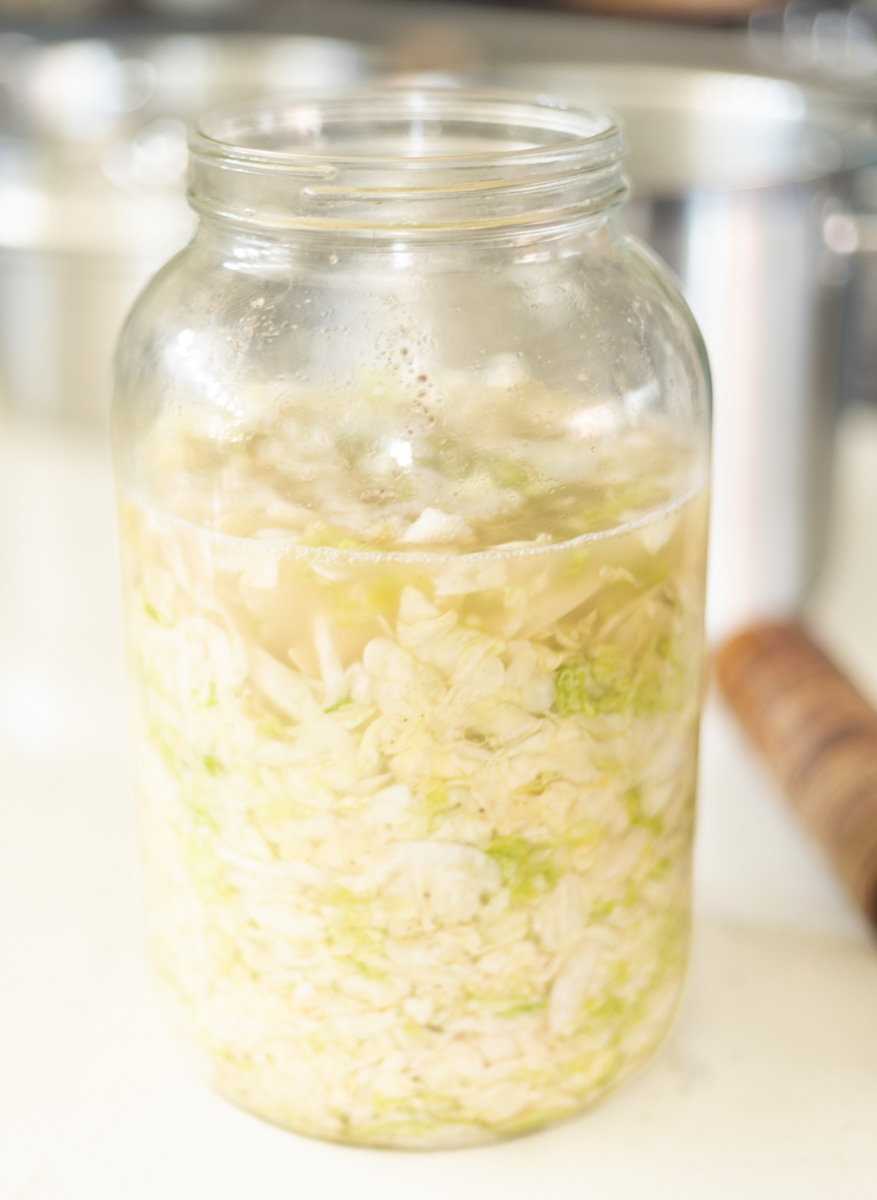
Sauerkraut is a German word meaning “sour cabbage.” It’s known as “the king of probiotics!”
Sauerkraut is made by mixing cabbage and salt in the right proportions (2-3% salt by weight of the whole cabbage), then packing it into a glass jar or crock and letting it ferment at room temperature. Once it’s fermented, you can store it long-term in cold storage like a root cellar or fridge for months or even years!
Home fermented saurkraut can replace purchased probiotics and provide a wider spectrum of beneficial bacteria for a fraction of the price!
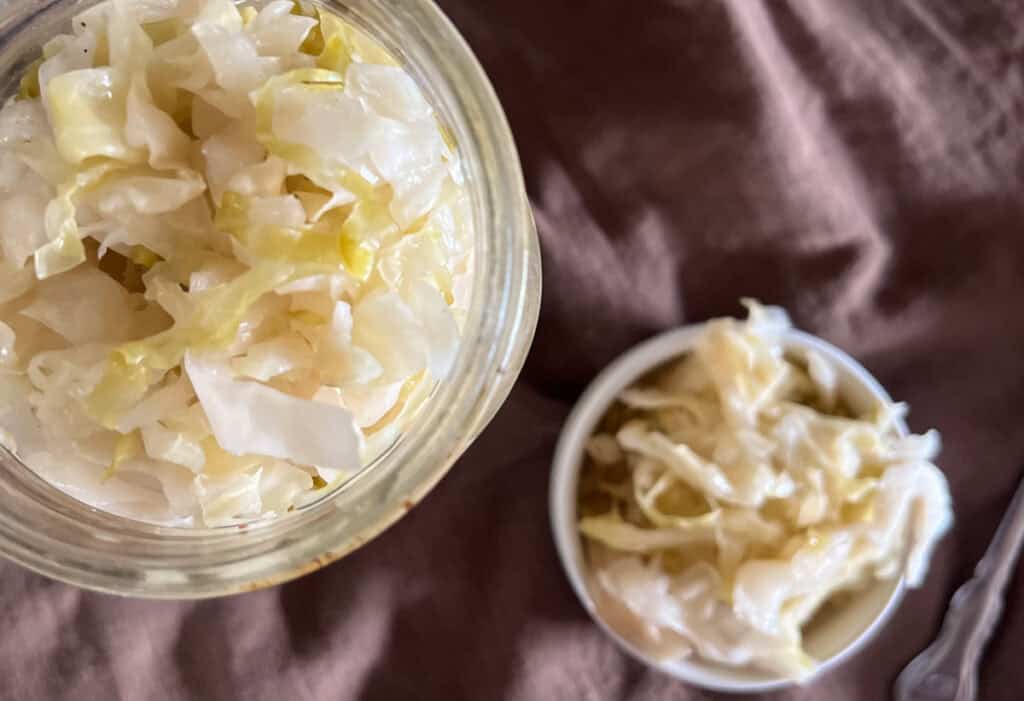
I may receive a small commission for items purchased through affiliate links in this post at no additional cost to you.
Why You’ll Love This Recipe
- Fermented sauerkraut is super easy to make, the hardest part is not eating it all before the 2-week mark when it’s fully fermented!
- Home ferments should be a staple in everyone’s diet – and before home refrigeration they were! Fridges have made fermentation unnecessary for long-term food storage, but the human microbiome hasn’t gotten the memo. We still need the beneficial gut bacteria from fermented foods in our daily diet.
- This is just a base raw sauerkraut recipe made with 2 simple ingredients – you can spice it up with herbs, garlic, onion, spices, etc
Want to spend the day with me in my homestead kitchen cooking and fermenting? Here’s the video.
What You’ll Need
INGREDIENTS
- whole organic cabbage – if you’re looking for health benefits, organic is important to avoid as many toxins as possible.
- 2 teaspoons salt per pound of cabbage – salt quality matters! I use Redmond real salt for almost all my kitchen tasks, including fermenting.
Step-By-Step Instructions
- Remove the outer leaves from the cabbage and set 1 or 2 to the side.
- Quarter the cabbage and remove the hard core.
- Slice the cabbage into 1/4″ thick strips and place the sliced cabbage in a large bowl.
- Add the salt and toss to coat the cabbage, then let it set for 30 minutes to “sweat”
- Pack the cabbage into a jar or crock with a cabbage stomper until all of the cabbage is covered in its own brine. You should NOT need to add any water, the liquid is all drawn out of the cabbage by the salt.
- Place one of the whole cabbage leaves over the shredded cabbage to keep little pieces from floating to the top of the brine and molding. Place a fermentation weight on top and seal the jar/crock.
- “Burp” the jar every day by opening the lid to let the gas out and then fastening it again.
- You can try the sauerkraut after a few days, but it won’t be fully fermented until at least 2 weeks. Let it ferment for up to 4 weeks and store it in the refrigerator for months. Eat a little bit of raw fermented sauerkraut for a daily dose of live probiotics or cook the kraut and serve with a meal. Fresh sauerkraut is a great way to support your immune system and promote a healthy gut.
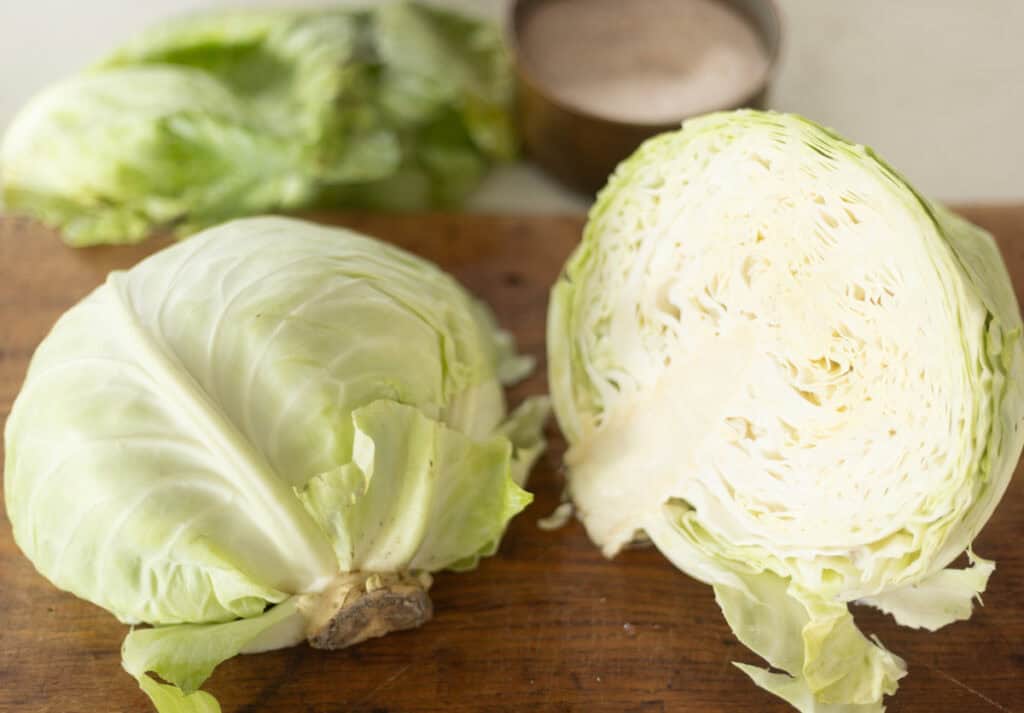
FAQ
1. Why Does Sauerkraut Sometimes Turn Out Soft?
- Sauerkraut can turn out soft due to too little salt, high temperatures, or fermenting for too long. Proper salt levels, temperature, and fermentation time are key for a crunchy texture.
2. Can I Add Other Ingredients?
- Yes, you can add various vegetables and spices. Common additions include shredded carrots, onions, garlic, and beets for flavor and color, as well as caraway seeds, dill, mustard seeds, and juniper berries for distinct tastes. Mix these organic ingredients with the cabbage before fermenting to ensure even distribution and flavor throughout. This is also a great way to add a probiotic boost to your raw cultured vegetables.
3. What If There’s Mold on Top?
- Mold on the surface of sauerkraut can be skimmed off, as it doesn’t necessarily spoil the entire batch. Ensure the sauerkraut remains submerged in brine to prevent further mold growth. Keeping the cabbage under the liquid level and away from direct sunlight helps maintain good bacteria while preventing mold.
4. How Long Does it take to Ferment Sauerkraut?
- Fermentation time can vary depending on temperature and personal taste. It usually takes 2-4 weeks at room temperature (65-75°F or 18-24°C). For best results, monitor the sauerkraut’s flavor and texture, and adjust the fermentation time based on your preference for tangy flavor
5. How Do I Know When the Sauerkraut is Ready?
- Taste is the best indicator. The sauerkraut should be tangy and crunchy. You can start tasting it after a week and ferment it longer if desired for a more pronounced flavor and probiotic benefits.
6. What Type of Cabbage Should I Use?
- You can use any variety of cabbage, but organic green cabbage is the most common choice for sauerkraut due to its superior flavor and texture. Purple cabbage is another option, offering a colorful variation and an added boost of vitamin C.
7. Do I Need to Add Water to the Sauerkraut?
- No, you don’t need to add water. The salt draws out the cabbage’s natural moisture, creating its own brine.
8. Can I Use Iodized Salt?
- It’s best to use non-iodized salt, like sea salt or kosher salt, as iodized salt can interfere with fermentation.
9. How much salt should I use?
- Use about 2% of the weight of the cabbage in salt. This typically equates to 2 tablespoons of salt per pound of cabbage. This helps create the right conditions for lactic acid bacteria to thrive, ensuring the best kraut.
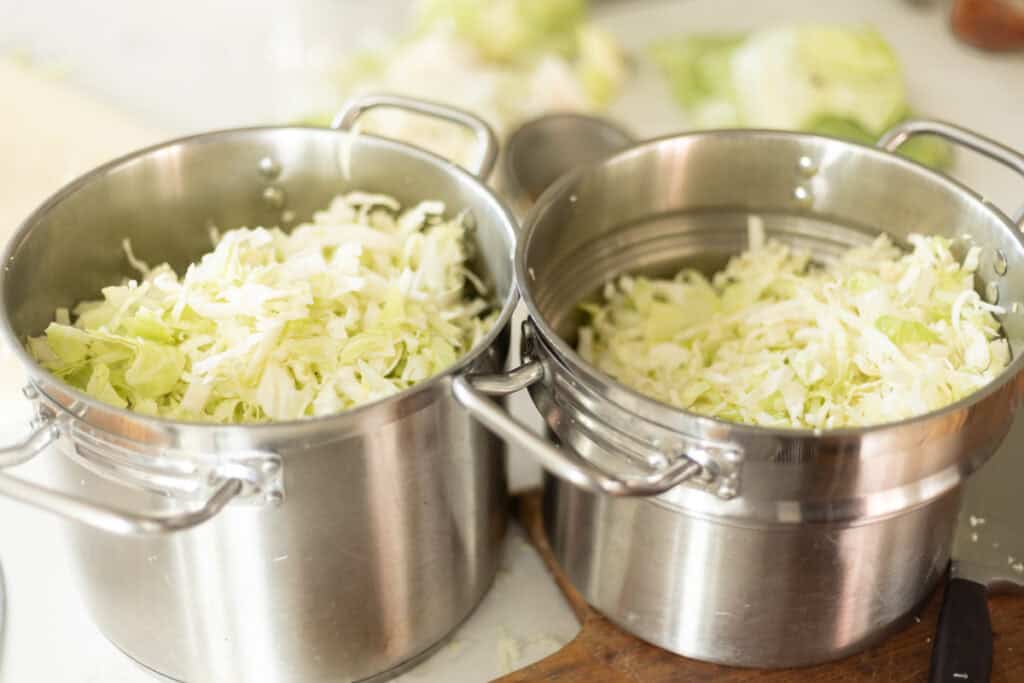
Tips
- Massage the salt into the cabbage thoroughly to help draw out moisture and create a brine.
- Keep the cabbage fully submerged under the brine to prevent exposure to air, which can lead to mold.
- Shred the cabbage uniformly to ensure even fermentation and a consistent texture.
- Place a clean weight or a small, sanitized jar on top of the cabbage to keep it submerged and to prevent floating.
- Monitor the sauerkraut for any signs of mold or off smells and ensure the cabbage remains covered by brine.
- Don’t hesitate to add herbs, spices, or other vegetables to create unique flavor profiles.
- Store the sauerkraut in a dark place to maintain its quality and protect the beneficial bacteria from light exposure.
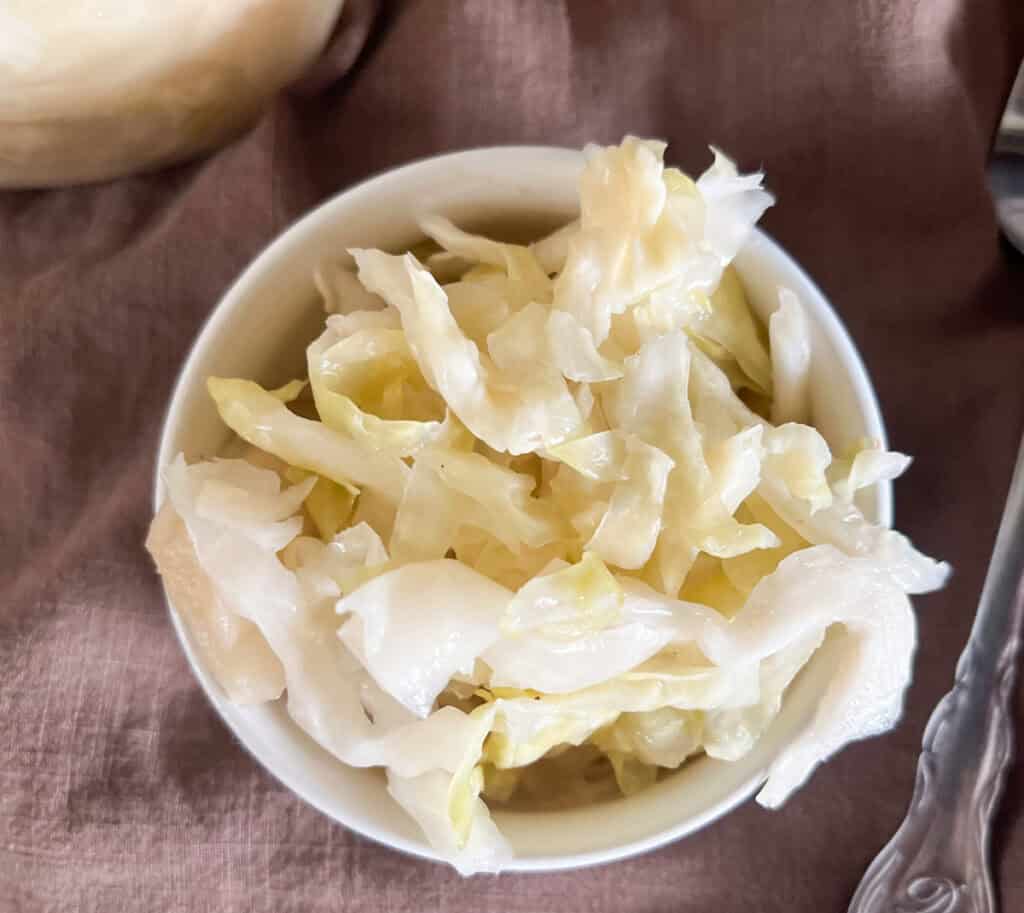
Storage
- Room temperature storage: Freshly fermented sauerkraut can be kept at room temperature (65-75°F or 18-24°C) for up to a week, depending on your fermentation preferences. After this period, it should be moved to the refrigerator to prevent over-fermentation.
- Refrigerator: Once fermented to your liking, sauerkraut should be stored in the refrigerator. It will keep well for several months. The cold slows down the fermentation process, maintaining the sauerkraut’s flavor and texture. This helps extend its shelf life and preserve its natural fermentation process.
- Freezer: Freezing sauerkraut is not recommended, as it can negatively affect the texture, making it mushy once thawed. The freezing process also can alter its flavor and fermentation quality, reducing the benefits of probiotic foods. While stored in the refrigerator, unpasteurized sauerkraut will continue to benefit your gut microbiota by maintaining its live beneficial bacteria. However, freezing is not recommended as it can disrupt these beneficial cultures.

How to Make Probiotic Sauerkraut – Fermented Raw Foods
Ingredients
Equipment
Method
- Remove the outer leaves from the cabbage and set 1 or 2 to the side.
- Quarter the cabbage and remove the hard core.
- Slice the cabbage into 1/4" thick strips and place the sliced cabbage in a large bowl.
- Add the salt and toss to coat the cabbage, then let it set for 30 minutes to "sweat"
- Pack the cabbage into a jar or crock with a cabbage stomper until all of the cabbage is covered in its own brine. You should NOT need to add any water, the liquid is all drawn out of the cabbage by the salt.
- Place one of the whole cabbage leaves over the shredded cabbage to keep little pieces from floating to the top of the brine and molding. Place a fermentation weight on top and seal the jar/crock.
- "Burp" the jar every day by opening the lid to let the gas out and then fastening it again.
- You can try the sauerkraut after a few days, but it won't be fully fermented until at least 2 weeks. Let it ferment for up to 4 weeks and store it in the refrigerator for months. Eat a little bit of raw fermented sauerkraut for a daily dose of live probiotics or cook the kraut and serve with a meal. Fresh sauerkraut is a great way to support your immune system and promote a healthy gut.
Nutrition
Notes
Tips
- Massage the salt into the cabbage thoroughly to help draw out moisture and create a brine.
- Keep the cabbage fully submerged under the brine to prevent exposure to air, which can lead to mold.
- Shred the cabbage uniformly to ensure even fermentation and a consistent texture.
- Place a clean weight or a small, sanitized jar on top of the cabbage to keep it submerged and to prevent floating.
- Monitor the sauerkraut for any signs of mold or off smells and ensure the cabbage remains covered by brine.
- Don’t hesitate to add herbs, spices, or other vegetables to create unique flavor profiles.
- Store the sauerkraut in a dark place to maintain its quality and protect the beneficial bacteria from light exposure.
Storage
- Room temperature storage: Freshly fermented sauerkraut can be kept at room temperature (65-75°F or 18-24°C) for up to a week, depending on your fermentation preferences. After this period, it should be moved to the refrigerator to prevent over-fermentation.
- Refrigerator: Once fermented to your liking, sauerkraut should be stored in the refrigerator. It will keep well for several months. The cold slows down the fermentation process, maintaining the sauerkraut's flavor and texture. This helps extend its shelf life and preserve its natural fermentation process.
- Freezer: Freezing sauerkraut is not recommended, as it can negatively affect the texture, making it mushy once thawed. The freezing process also can alter its flavor and fermentation quality, reducing the benefits of probiotic foods. While stored in the refrigerator, unpasteurized sauerkraut will continue to benefit your gut microbiota by maintaining its live beneficial bacteria. However, freezing is not recommended as it can disrupt these beneficial cultures.
Tried this recipe?
Let us know how it was!More Recipes Like This
Easy Matcha Clove Gut Healing Smoothie made with Kefir
Super Gut SIBO Yogurt Recipe (Reuteri, Gasseri, Coagulans)
The BEST Gut Healing Chicken Soup – Healthy Recipe


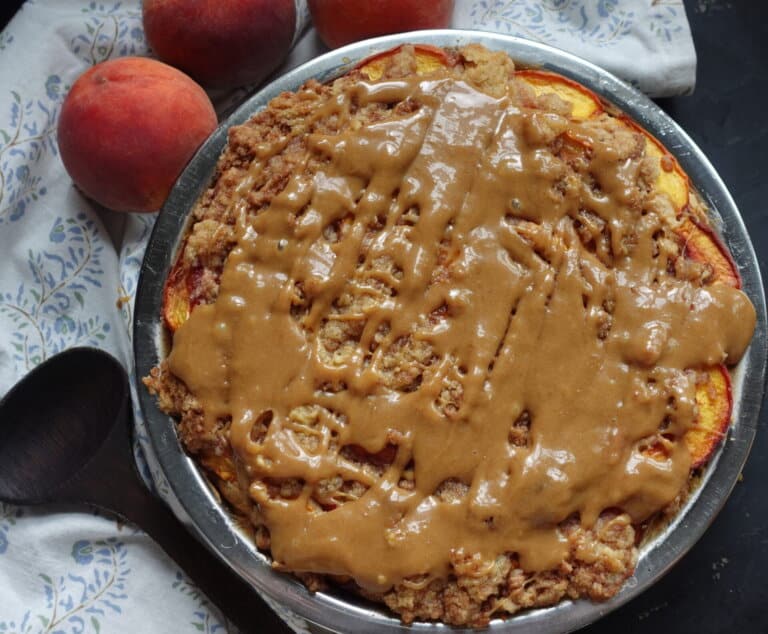

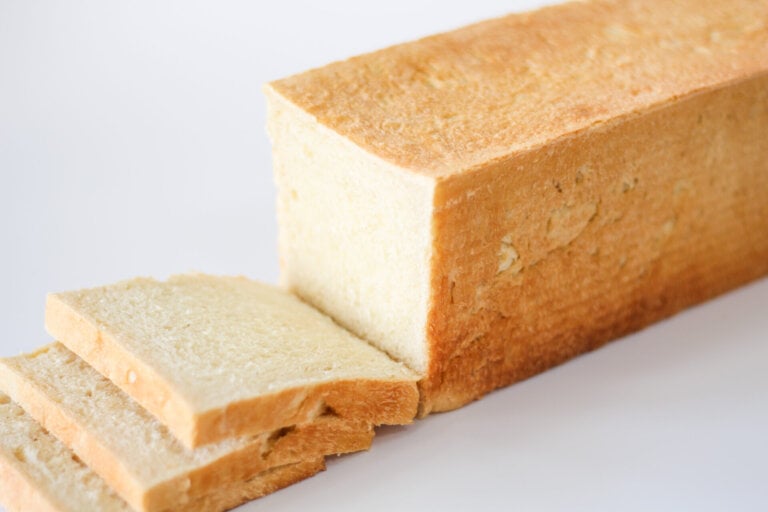


Very good https://is.gd/tpjNyL